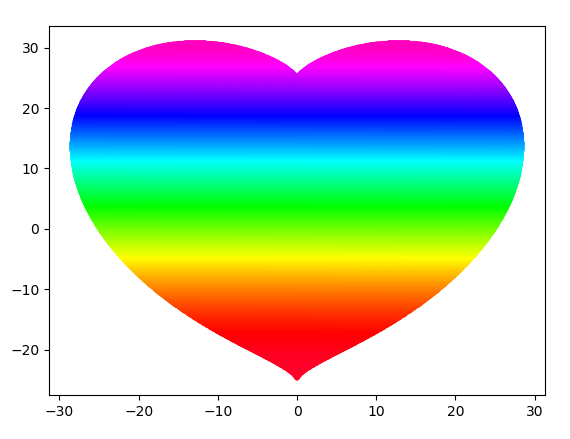目录
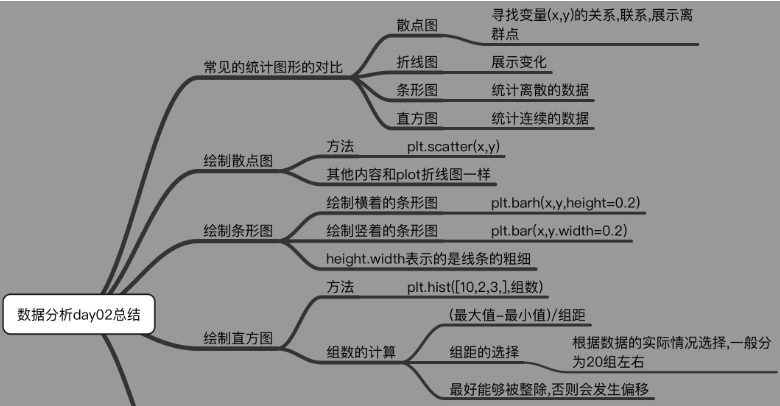
散点图
![]()

假设通过爬虫你获取到了北京2016年3,10月份每天白天的最高气温(分别位于列表a,b),那么此时如何寻找出气温和随时间(天)变化的某种规律?
a = [11,17,16,11,12,11,12,6,6,7,8,9,12,15,14,17,18,21,16,17,20,14,15,15,15,19,21,22,22,22,23]
b = [26,26,28,19,21,17,16,19,18,20,20,19,22,23,17,20,21,20,22,15,11,15,5,13,17,10,11,13,12,13,6]
from matplotlib import pyplot as plt from matplotlib import font_manager my_font = font_manager.FontProperties(fname="./Hiragino Sans GB.ttc") x_3 = range(1, 32) x_10 = range(51, 82) y_3 = [11,17,16,11,12,11,12,6,6,7,8,9,12,15,14,17,18,21,16,17,20,14,15,15,15,19,21,22,22,22,23] y_10 = [26,26,28,19,21,17,16,19,18,20,20,19,22,23,17,20,21,20,22,15,11,15,5,13,17,10,11,13,12,13,6] plt.figure(figsize=(15, 8), dpi=80) # 绘制散点图 plt.scatter(x_3, y_3, label='3月份') plt.scatter(x_10, y_10, label='4月份') # 设置x轴y轴 _x = list(x_3) + list(x_10) _y = list(y_3) + list(y_10) x_ticks = ['3月{}日'.format(i) for i in x_3] x_ticks += ['10月{}日'.format(i-50) for i in x_10] plt.xticks(_x[::3], x_ticks[::3], fontproperties=my_font, rotation=45) plt.yticks(range(min(_y), max(_y)+1)) plt.xlabel('3月与10月日期', fontproperties=my_font, size=15) plt.ylabel('气温', fontproperties=my_font, size=15) plt.title('3月份与10月份每日平均气温变化散点图', fontproperties=my_font, size=20) plt.grid(alpha=0.5, color='c') plt.legend(loc='0', prop=my_font) plt.show()
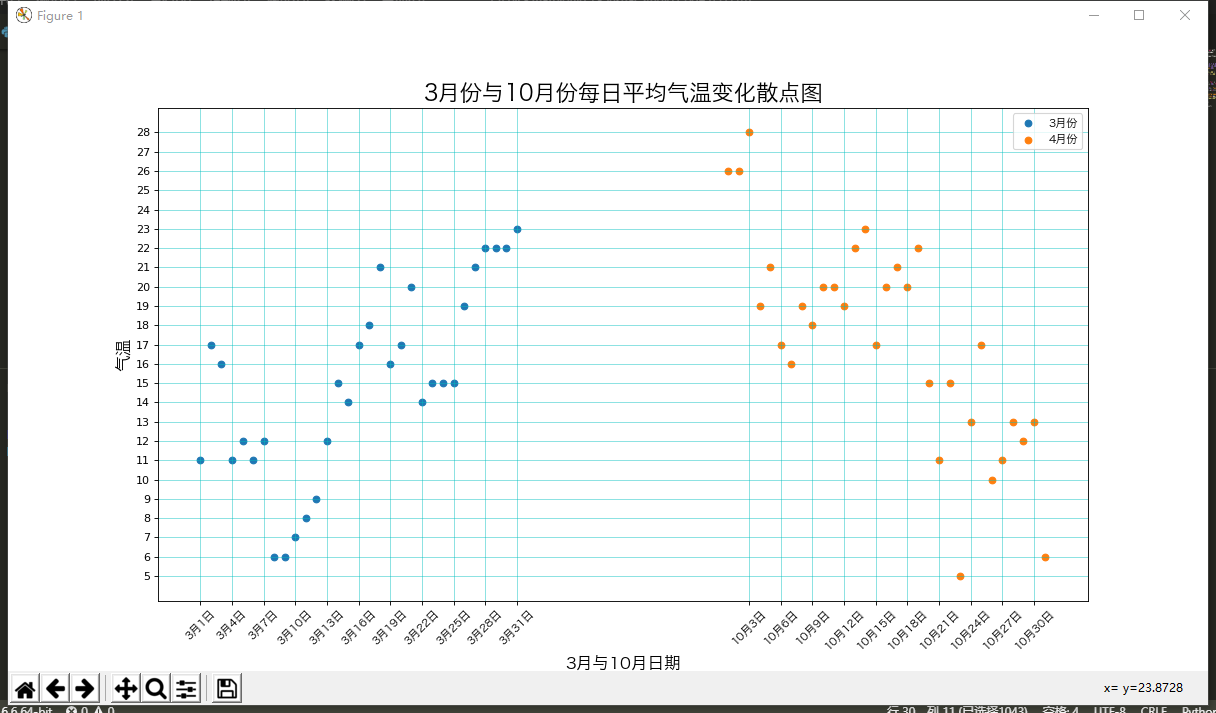
可以看出,3月气温逐渐在上升,到了10月逐渐下降
爱心表白程序
import numpy as np import matplotlib.pyplot as plt # 确定一个线性范围, x_cord = np.linspace(-100, 100, 2000) # -100到100之间取2000个点 y_cord = np.linspace(-100, 100, 2000) pots = [] for y in y_cord: for x in x_cord: # 0.04是为了将打印的图片变小,运行速度快一些 if ((x*0.04)**2+(y*0.04)**2-1)**3-(x*0.04)**2*(y*0.04)**3 <= 0: pots.append({'x': x, 'y': y}) # 画图 ht_x = list(map(lambda point: point['x'], pots)) ht_y = list(map(lambda point: point['y'], pots)) plt.scatter(ht_x, ht_y, s=4, c=range(len(ht_y)), cmap='gist_rainbow') # s: 点的大小 c:颜色范围设置cmap:颜色渐变 plt.show()
条形图

假设你获取到了2017年内地电影票房前20的电影(列表a)和电影票房数据(列表b),那么如何更加直观的展示该数据?
a = ["战狼2","速度与激情8","功夫瑜伽","西游伏妖篇","变形金刚5:最后的骑士","摔跤吧!爸爸","加勒比海盗5:死无对证","金刚:骷髅岛","极限特工:终极回归","生化危机6:终章","乘风破浪","神偷奶爸3","智取威虎山","大闹天竺","金刚狼3:殊死一战","蜘蛛侠:英雄归来","悟空传","银河护卫队2","情圣","新木乃伊",]
b=[56.01,26.94,17.53,16.49,15.45,12.96,11.8,11.61,11.28,11.12,10.49,10.3,8.75,7.55,7.32,6.99,6.88,6.86,6.58,6.23] 单位:亿
首先按照常规设计:(plt.bar(a, b))
from matplotlib import pyplot as plt from matplotlib import font_manager my_font = font_manager.FontProperties(fname="./Hiragino Sans GB.ttc") a = ["战狼2","速度与激情8","功夫瑜伽","西游伏妖篇","变形金刚5: 最后的骑士",
"摔跤吧!爸爸","加勒比海盗5: 死无对证","金刚: 骷髅岛","极限特工: 终极回归",
"生化危机6: 终章","乘风破浪","神偷奶爸3","智取威虎山","大闹天竺","金刚狼3: 殊死一战",
"蜘蛛侠: 英雄归来","悟空传","银河护卫队2","情圣","新木乃伊",] b=[56.01,26.94,17.53,16.49,15.45,12.96,11.8,11.61,11.28,11.12,10.49,10.3,8.75,7.55,7.32,6.99,6.88,6.86,6.58,6.23] plt.figure(figsize=(15, 8), dpi=80) # 绘制竖的条形图 plt.bar(range(len(a)), b, width=0.5, color='orange') _x = a plt.xticks(range(len(a)), _x, fontproperties=my_font, rotation=45) plt.xlabel('电影', fontproperties=my_font, size=15) plt.ylabel('票房(单位:亿)', fontproperties=my_font, size=15) plt.title('电影票房统计', fontproperties=my_font, size=20) plt.grid(alpha=0.5, color='b') plt.show()
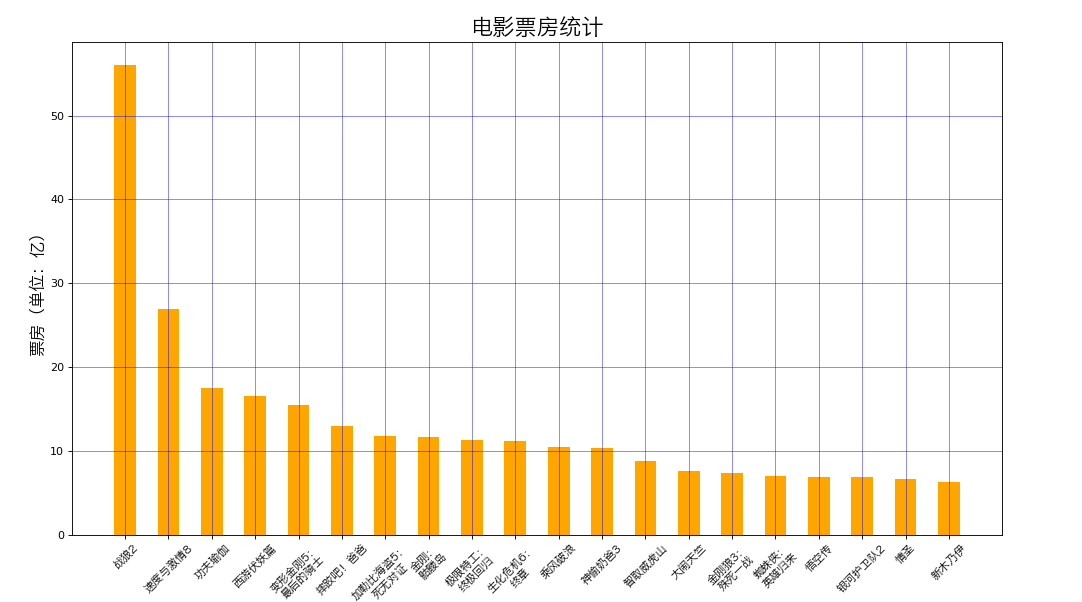
from matplotlib import pyplot as plt from matplotlib import font_manager my_font = font_manager.FontProperties(fname="./Hiragino Sans GB.ttc") a = ["战狼2","速度与激情8","功夫瑜伽","西游伏妖篇","变形金刚5:最后的骑士",
"摔跤吧!爸爸","加勒比海盗5:死无对证","金刚:骷髅岛","极限特工:终极回归",
"生化危机6:终章","乘风破浪","神偷奶爸3","智取威虎山","大闹天竺","金刚狼3:殊死一战",
"蜘蛛侠:英雄归来","悟空传","银河护卫队2","情圣","新木乃伊",] b = [56.01,26.94,17.53,16.49,15.45,12.96,11.8,11.61,11.28,11.12,10.49,10.3,8.75,7.55,7.32,6.99,6.88,6.86,6.58,6.23] plt.figure(figsize=(15, 8), dpi=80) # 绘制横条形图 plt.barh(range(len(a)), b, color='orange', height=0.4) # 绘制字符串到y轴 plt.yticks(range(len(a)), a, fontproperties=my_font) plt.xticks(range(5, 60, 5)) plt.grid() plt.show()
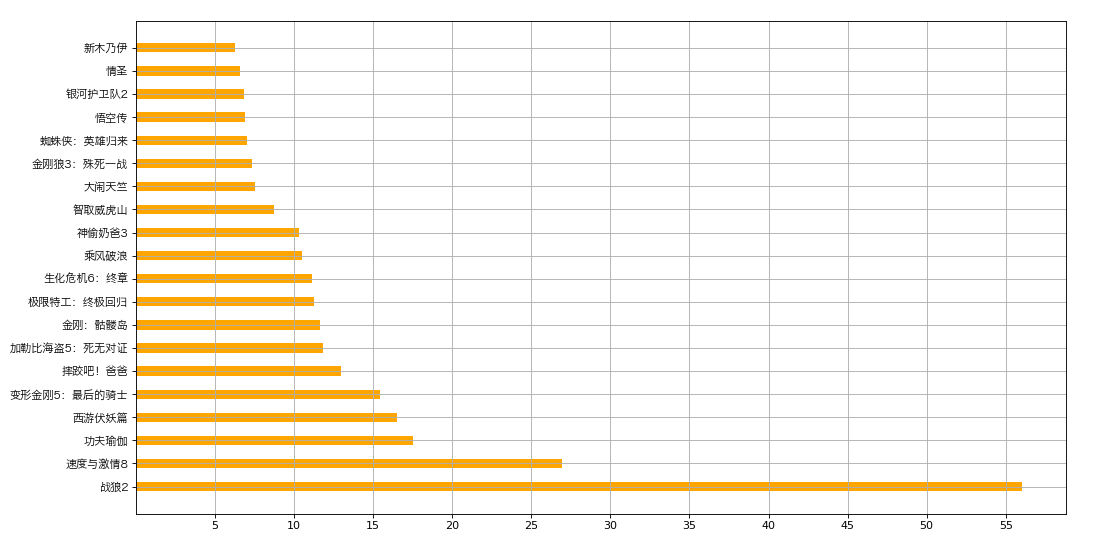
可以看出战狼2票房吊打其余电影
假设你知道了列表a中电影分别在2017-09-14(b_14), 2017-09-15(b_15), 2017-09-16(b_16)三天的票房,为了展示列表中电影本身的票房以及同其他电影的数据对比情况,应该如何更加直观的呈现该数据?
a = ["猩球崛起3:终极之战","敦刻尔克","蜘蛛侠:英雄归来","战狼2"]
b_16 = [15746,312,4497,319]
b_15 = [12357,156,2045,168]
b_14 = [2358,399,2358,362]
from matplotlib import pyplot as plt from matplotlib import font_manager my_font = font_manager.FontProperties(fname="./Hiragino Sans GB.ttc") a = ["猩球崛起3:终极之战","敦刻尔克","蜘蛛侠:英雄归来","战狼2"] b_16 = [15746,312,4497,319] b_15 = [12357,156,2045,168] b_14 = [2358,399,2358,362] plt.figure(figsize=(15, 8), dpi=80) # 设置一个变量决定条形图的宽度,因为有三条数据,所以宽度不能大于0.333 # 大于1就会出现重叠 width_num = 0.25 # 设置x轴 # 逐个加0.2,就会出现不同数据相邻的效果 _x_14 = [i for i in range(len(a))] _x_15 = [i+width_num for i in range(len(a))] _x_16 = [i+width_num+width_num for i in range(len(a))] # 绘制条形图 plt.bar(_x_14, b_14, width=width_num, label='9月14') plt.bar(_x_15, b_15, width=width_num, label='9月15') plt.bar(_x_16, b_16, width=width_num, label='9月16')
# xticks选择_x_15是因为15在中间位置,显示文字的话好看一些 plt.xticks(_x_15, a, fontproperties=my_font, size=15) plt.legend(prop=my_font) plt.grid() plt.xlabel('电影', fontproperties=my_font, size=15) plt.ylabel('票房(单位:张)', fontproperties=my_font, size=15) plt.title('2017年9月14,15,16日票房对比图', fontproperties=my_font, size=20) plt.show()
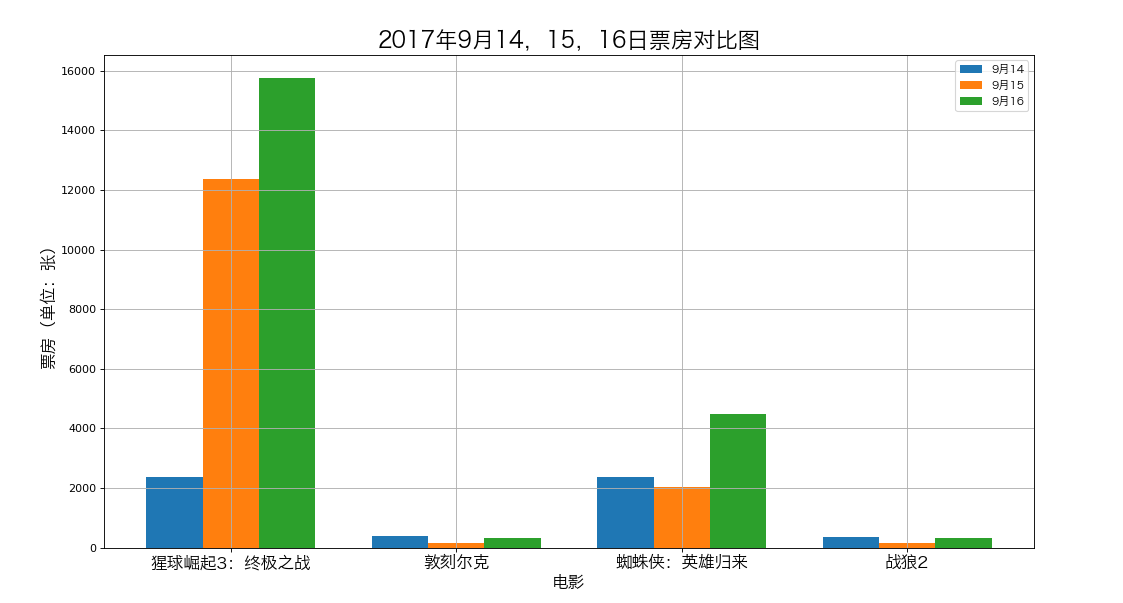
可以看出猩球崛起电影票房大卖
直方图
假设你获取了250部电影的时长(列表a中),希望统计出这些电影时长的分布状态
(比如时长为100分钟到120分钟电影的数量,出现的频率)等信息,你应该如何呈现这些数据?
a=[131, 98, 125, 131, 124, 139, 131, 117, 128, 108, 135, 138, 131, 102, 107, 114, 119, 128, 121, 142, 127, 130, 124, 101, 110, 116, 117, 110, 128, 128, 115, 99, 136, 126, 134, 95, 138, 117, 111,78, 132, 124, 113, 150, 110, 117, 86, 95, 144, 105, 126, 130,126, 130, 126, 116, 123, 106, 112, 138, 123, 86, 101, 99, 136,123, 117, 119, 105, 137, 123, 128, 125, 104, 109, 134, 125, 127,105, 120, 107, 129, 116, 108, 132, 103, 136, 118, 102, 120, 114,105, 115, 132, 145, 119, 121, 112, 139, 125, 138, 109, 132, 134,156, 106, 117, 127, 144, 139, 139, 119, 140, 83, 110, 102,123,107, 143, 115, 136, 118, 139, 123, 112, 118, 125, 109, 119, 133,112, 114, 122, 109, 106, 123, 116, 131, 127, 115, 118, 112, 135,115, 146, 137, 116, 103, 144, 83, 123, 111, 110, 111, 100, 154,136, 100, 118, 119, 133, 134, 106, 129, 126, 110, 111, 109, 141,120, 117, 106, 149, 122, 122, 110, 118, 127, 121, 114, 125, 126,114, 140, 103, 130, 141, 117, 106, 114, 121, 114, 133, 137, 92,121, 112, 146, 97, 137, 105, 98, 117, 112, 81, 97, 139, 113,134, 106, 144, 110, 137, 137, 111, 104, 117, 100, 111, 101, 110,105, 129, 137, 112, 120, 113, 133, 112, 83, 94, 146, 133, 101,131, 116, 111, 84, 137, 115, 122, 106, 144, 109, 123, 116, 111,111, 133, 150]
from matplotlib import pyplot as plt from matplotlib import font_manager my_font = font_manager.FontProperties(fname="./Hiragino Sans GB.ttc") a=[131, 98, 125, 131, 124, 139, 131, 117, 128, 108, 135, 138, 131, 102, 107,
114, 119, 128, 121, 142, 127, 130, 124, 101, 110, 116, 117, 110, 128, 128,
115, 99, 136, 126, 134, 95, 138, 117, 111,78, 132, 124, 113, 150, 110, 117,
86, 95, 144, 105, 126, 130,126, 130, 126, 116, 123, 106, 112, 138, 123, 86,
101, 99, 136,123, 117, 119, 105, 137, 123, 128, 125, 104, 109, 134, 125, 127,
105, 120, 107, 129, 116, 108, 132, 103, 136, 118, 102, 120, 114,105, 115, 132,
145, 119, 121, 112, 139, 125, 138, 109, 132, 134,156, 106, 117, 127, 144,
139, 139, 119, 140, 83, 110, 102,123,107, 143, 115, 136, 118, 139, 123, 112,
118, 125, 109, 119, 133,112, 114, 122, 109, 106, 123, 116, 131, 127, 115,
118, 112, 135,115, 146, 137, 116, 103, 144, 83, 123, 111, 110, 111, 100,
154,136, 100, 118, 119, 133, 134, 106, 129, 126, 110, 111, 109, 141,120,
117, 106, 149, 122, 122, 110, 118, 127, 121, 114, 125, 126,114, 140, 103,
130, 141, 117, 106, 114, 121, 114, 133, 137, 92,121, 112, 146, 97, 137,
105, 98, 117, 112, 81, 97, 139, 113,134, 106, 144, 110, 137, 137, 111,
104, 117, 100, 111, 101, 110,105, 129, 137, 112, 120, 113, 133, 112, 83,
94, 146, 133, 101,131, 116, 111, 84, 137, 115, 122, 106, 144, 109, 123, 116, 111,111, 133, 150] # 组距 d = 3 # 计算组数 num_bins = (max(a) - min(a)) // d plt.figure(figsize=(15, 8), dpi=80) plt.hist(a, num_bins) # 列表,组数 # plt.hist(a, num_bins, density=True) # 显示概率 plt.xticks(range(min(a), max(a)+d, d)) plt.grid() plt.show()
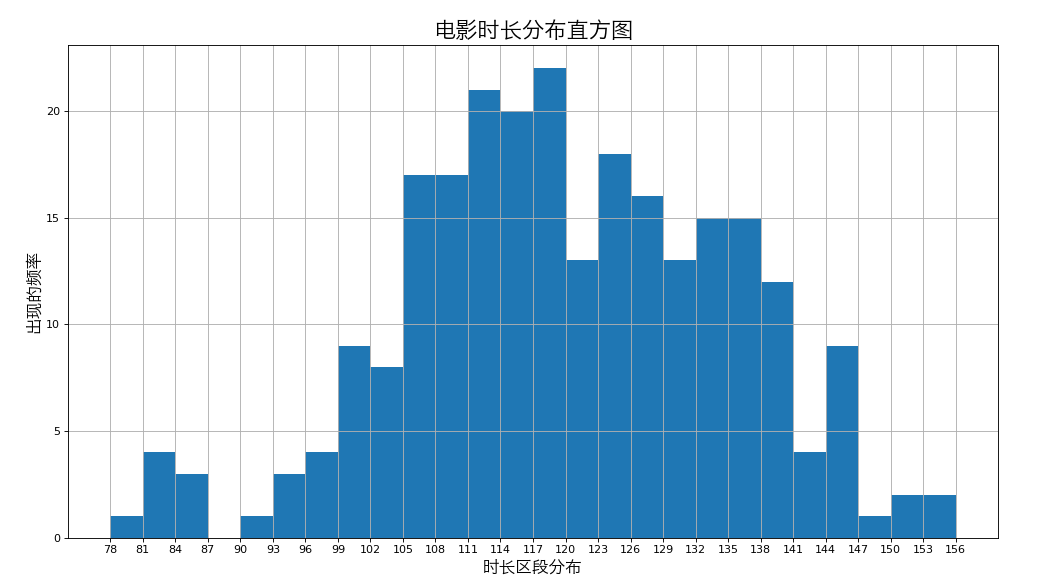
可以看出电影时长在111到120的居多
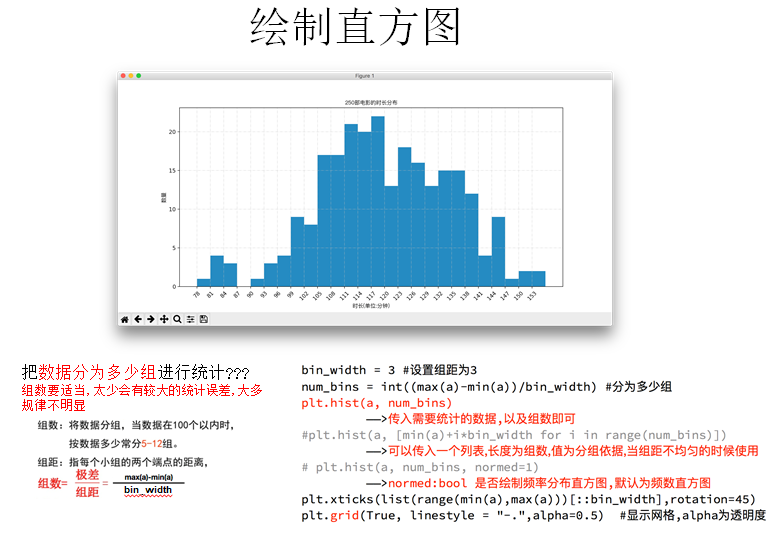
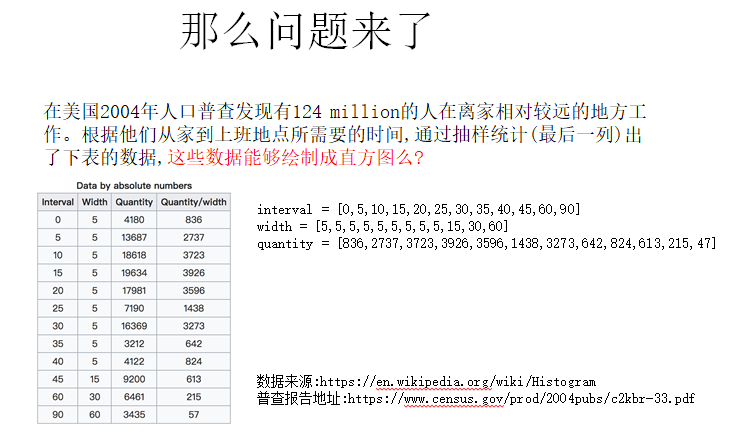
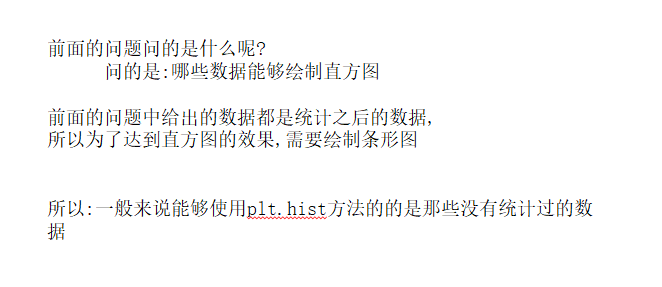
# -*- coding: utf-8 -*- """ ------------------------------------------------- File Name: 条形图3 Description : Author : wjh date: 2019/5/1 File Path: Python ------------------------------------------------- """ from matplotlib import pyplot as plt from matplotlib import font_manager my_font = font_manager.FontProperties(fname="./Hiragino Sans GB.ttc") interval = [0,5,10,15,20,25,30,35,40,45,60,90] width = [5,5,5,5,5,5,5,5,5,15,30,60] quantity = [836,2737,3723,3926,3596,1438,3273,642,824,613,215,47] # 设置条形图大小 plt.figure(figsize=(15, 8), dpi=80) # 将条形图向右移动0.5 _x = [i+0.5 for i in range(len(quantity))] # 绘制条形图 width=1:条形图相邻,默认0.8 plt.bar(_x, quantity, width=1) # 设置x轴刻度 plt.xticks(range(len(quantity)+1), interval+[150]) plt.show()
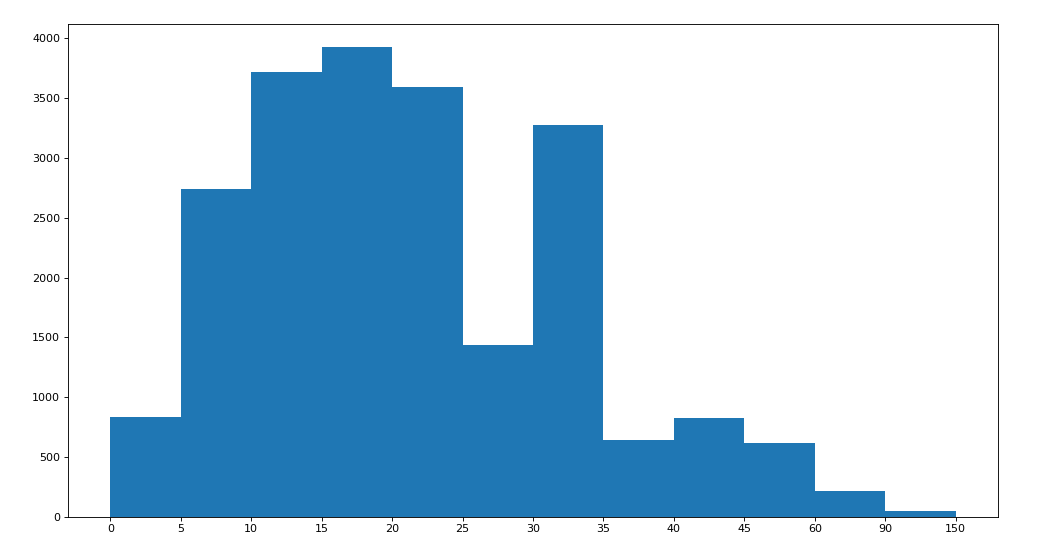
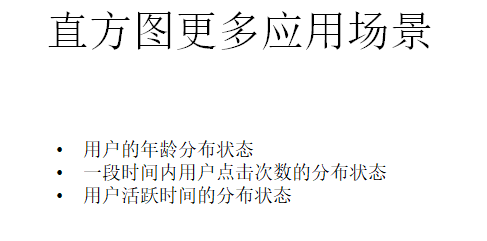
总结
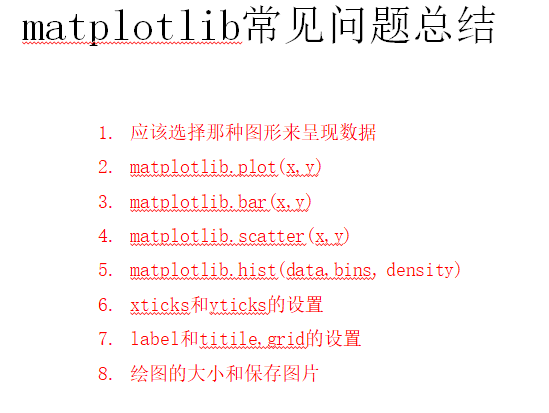
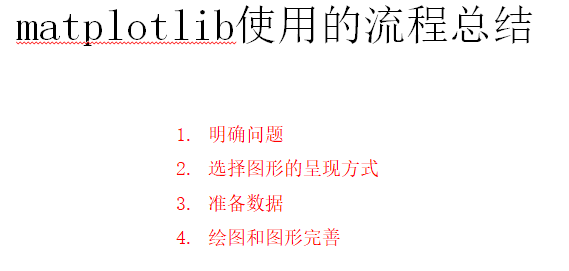
四种图形使用情况对比
-
观察变化的时候使用 折线图,plot
-
观察不同维度之间的关系 散点图 ,scatter
-
统计离散的数据 条形图 bar,barh
-
统计连续的数据 直方图 hist
scatter
-
plt.scatter(x,y)
bar,barh
-
plt.bar(x,y,width=0.3)
-
plt.bar(x,y,height=0.3)
hist
-
plt.hist([1,2,3],组数)
-
组数=(最大值-最小值)/ 组距
